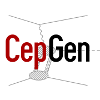Structure functions#
This documentation page lists all \(F_{2/L}(\xbj,Q^2)\) nucleon structure functions types modelled and embedded in the CepGen library. These modellings are intensively used in the photon fluxes computation, and each of these are tuned for a specific kinematics range.
All parameterisations derive from the following base class:
-
class Parameterisation : public NamedModule<Parameterisation>#
Base object for the parameterisation of nucleon structure functions.
Subclassed by EvolutionStructureFunctions, EvolutionStructureFunctions, StructureFunctions, ALLM, BlockDurandHa, BodekKangXu, CLAS, CapellaEtAl, ChristyBosted, DonnachieLandshoff, FioreBrasse, KulaginBarinov, PartonicParameterisation, Schaefer, Shamov, SuriYennie, SzczurekUleshchenko, Grid
Public Functions
-
inline const sigrat::Parameterisation *sigmaRatio() const#
Longitudinal/transverse cross section ratio parameterisation used to compute \(F_{1/L}\).
-
Parameterisation &operator()(double, double)#
Compute all relevant structure functions for a given \((x_{\rm Bj},Q^2)\) couple.
- Parameters:
xbj – [in] Bjorken’s x variable
q2 – [in] Squared 4-momentum transfer (in GeV^2)
-
double F2(double xbj, double q2)#
Transverse structure function.
-
double FL(double xbj, double q2)#
Longitudinal structure function.
-
double W1(double xbj, double q2)#
Longitudinal form factor.
-
double FE(double xbj, double q2)#
Electric proton form factor.
-
double FM(double xbj, double q2)#
Magnetic proton form factor.
-
double F1(double xbj, double q2)#
\(F_1\) structure function
-
inline const std::string &name() const#
Module unique indexing name.
-
inline bool operator==(const SteeredObject &oth) const#
Equality operator.
-
inline bool operator!=(const SteeredObject &oth) const#
Inequality operator.
-
inline virtual const ParametersList ¶meters() const override#
Module user-defined parameters.
-
inline virtual void setParameters(const ParametersList ¶ms) override#
Set module parameters.
-
inline void setDescribedParameters(const ParametersList ¶ms_orig)#
Set (documented) module parameters.
Public Static Functions
-
static ParametersDescription description()#
Generic description for the structure functions.
Friends
-
friend std::ostream &operator<<(std::ostream&, const Parameterisation&)#
Human-readable dump of the SF parameterisation at this (xBj,Q^2) value.
-
struct Arguments#
-
struct Values#
-
inline const sigrat::Parameterisation *sigmaRatio() const#
Note
All of these may be used and linked against any external code.
The parameterisation types handled in CepGen are listed in the cepgen::StructureFunctionsFactory.
Below, a semi-detailed review of a subset of the modellings handled in CepGen is presented.
Hybrid models#
As the name suggests, this class of model combines multiple extrapolation models valid in multiple kinematic ranges into a set of uniform, continuous structure functions.
Shamov#
Note
Legacy code:
302Structure functions modelled: \(W_1\), \(W_2\), \(F_2\)
-
class Shamov : public Parameterisation#
-
class Shamov : public Parameterisation#
This model is designed for soft, low-\(Q^2\) regimes under a broad range of \(x_{\rm Bj}\). Several operation modes are proposed, steered by the mode parameter:
SuriYennie, the standard, Suri and Yennie continuum (see below) ;RealRes, using a linear grid interpolation of the real photon cross section for \(Q^2\to 0\) with resonances dependance as for \(\Delta(1232)\) ;RealResAndNonRes, like the earlier, and using the Suri and Yennie non-resonant contribution ;RealAndSuriYennieNonRes, using the Suri and Yennie non-resonant contribution ;RealAndFitNonRes, like theRealResAndNonRes, but using a fit for the non-resonant contributions.
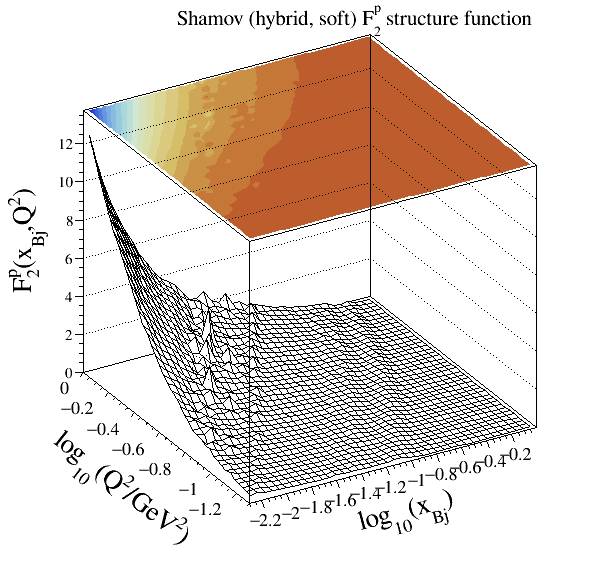
Kulagin-Barinov#
Note
Legacy code:
303Structure functions modelled: \(F_2\), \(F_L\)
Reference: [KB22]
-
class KulaginBarinov : public Parameterisation#
-
class KulaginBarinov : public Parameterisation#
Resonances are modelled through Breit-Wigner contributions from five states. For the DIS part, a higher twist correction is available from a global QCD fit.

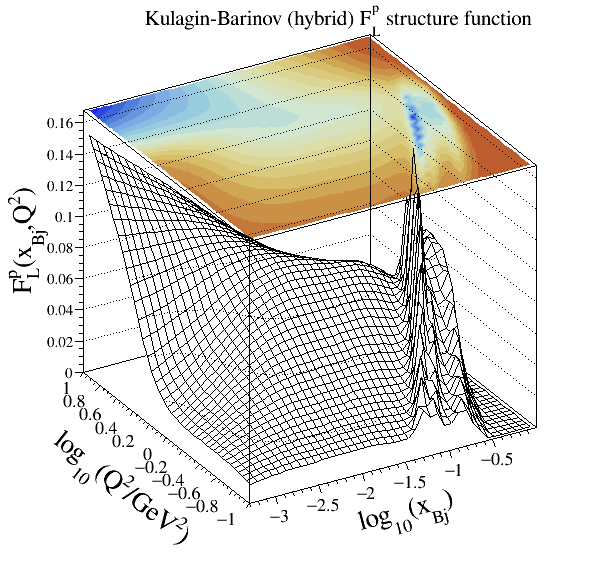
Bodek-Kang-Xu#
Note
Legacy code:
304Structure functions modelled: \(F_1\), \(F_2\)
Reference: [BYX21]
-
class BodekKangXu : public Parameterisation#
-
class BodekKangXu : public Parameterisation#
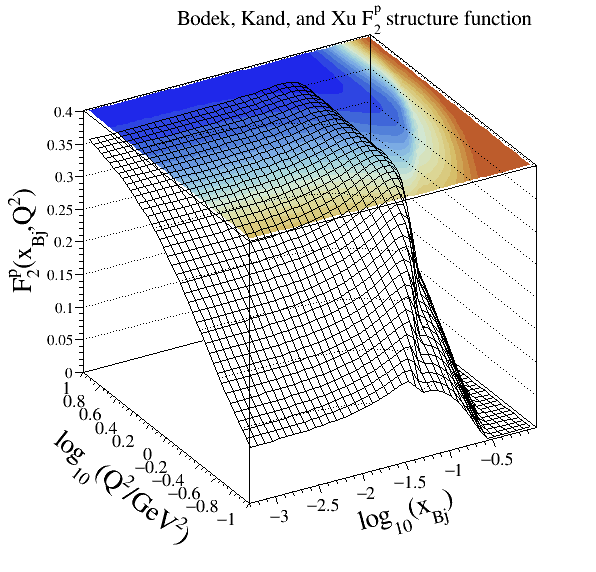

Continuum models#
Suri-Yennie#
Note
Legacy code:
11Structure functions modelled: \(F_E\), \(F_M\)
Reference: [SY72]
-
class SuriYennie : public Parameterisation#
Subclassed by SuriYennieAlt
-
class SuriYennie : public Parameterisation#
This set was used as a standard option in the LPAIR event generator. It provides a reasonable description of SLAC data in the resonance and continuum regions.

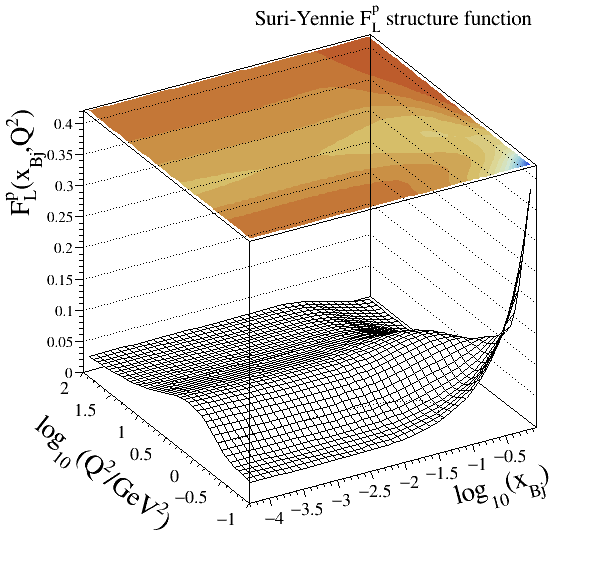
Szczurek-Uleshchenko#
Note
Legacy code:
12Structure function modelled: \(F_2\)
Reference: [SU00]
-
class SzczurekUleshchenko : public Parameterisation#
-
class SzczurekUleshchenko : public Parameterisation#
This set puts an emphasis on the low-to-intermediate \(Q^2\) region and includes a smooth continuation to low-\(Q^2\).
Block-Durand-Ha#
Note
Legacy code:
13Structure function modelled: \(F_2\)
Reference: [BDH14]
-
class BlockDurandHa : public Parameterisation#
-
class BlockDurandHa : public Parameterisation#
ALLM parameterisation#
Note
Legacy codes:
201(ALLM91),202(ALLM97),203(GD07p),204(GD11p)Structure function modelled: \(F_2\) [1]
References:
-
class ALLM : public Parameterisation#
Subclassed by ALLM91, ALLM97, GD07p, GD11p, HHTALLM, HHTALLMFT
-
class ALLM : public Parameterisation#
In this continuum region modelling the \(F_2\) proton structure function is parameterised as:
with \(m_0\) the effective photon mass. The pomeron/reggeon exchanges terms are parameterised as:
with the slowly-varying function \(t = t(Q^2)\) defined as:
and the modified Bjorken-\(x\) functions:
The six functionals \(a^{\Pom,\Reg}(t), b^{\Pom,\Reg}(t), c^{\Pom,\Reg}(t)\) are parameterised as:
for the pomeron part, and
for the reggeon subset.
Currently, four tunings of the 23 model parameters are embedded within CepGen:
Parameter |
Units |
ALLM91 |
ALLM97 |
GD07p |
GD11p |
|---|---|---|---|---|---|
\(m_0^2\) |
GeV\(^2\) |
0.30508 |
0.31985 |
0.454 |
0.5063 |
\(m _ {\Pom}^2\) |
GeV\(^2\) |
10.676 |
49.457 |
30.7 |
34.75 |
\(m _ {\Reg}^2\) |
GeV\(^2\) |
0.20623 |
0.15052 |
0.117 |
0.03190 |
\(Q_0^2\) |
GeV\(^2\) |
0.27799 |
0.52544 |
1.15 |
1.374 |
\(\Lambda_0^2\) |
GeV\(^2\) |
0.06527 |
0.06527 |
0.06527 |
0.06527 |
\(a^{\Pom}_1\) |
- |
-0.04503 |
-0.0808 |
-0.105 |
-0.11895 |
\(a^{\Pom}_2\) |
- |
-0.36407 |
-0.44812 |
-0.495 |
-0.4783 |
\(a^{\Pom}_3\) |
- |
8.17091 |
1.1709 |
1.29 |
1.353 |
\(b^{\Pom}_1\) |
- |
0.49222 |
0.36292 |
-1.42 |
1.0833 |
\(b^{\Pom}_2\) |
- |
0.52116 |
1.8917 |
4.51 |
2.656 |
\(b^{\Pom}_3\) |
- |
3.5515 |
1.8439 |
0.551 |
1.771 |
\(c^{\Pom}_1\) |
- |
0.26550 |
0.28067 |
0.339 |
0.3638 |
\(c^{\Pom}_2\) |
- |
0.04856 |
0.22291 |
0.127 |
0.1211 |
\(c^{\Pom}_3\) |
- |
1.04682 |
2.1979 |
1.16 |
1.166 |
\(a^{\Reg}_1\) |
- |
0.60408 |
0.584 |
0.374 |
0.3425 |
\(a^{\Reg}_2\) |
- |
0.17353 |
0.37888 |
0.998 |
1.0603 |
\(a^{\Reg}_3\) |
- |
1.61812 |
2.6063 |
0.775 |
0.5164 |
\(b^{\Reg}_1\) |
- |
1.26066 |
0.01147 |
2.71 |
-10.408 |
\(b^{\Reg}_2\) |
- |
1.83624 |
3.7582 |
1.83 |
14.857 |
\(b^{\Reg}_3\) |
- |
0.81141 |
0.49338 |
1.26 |
0.07739 |
\(c^{\Reg}_1\) |
- |
0.67639 |
0.80107 |
0.838 |
1.3633 |
\(c^{\Reg}_2\) |
- |
0.49027 |
0.97307 |
2.36 |
2.256 |
\(c^{\Reg}_3\) |
- |
2.66275 |
3.4942 |
1.77 |
2.209 |
The ALLM91 tuning is fitted from all pre-HERA data points available.
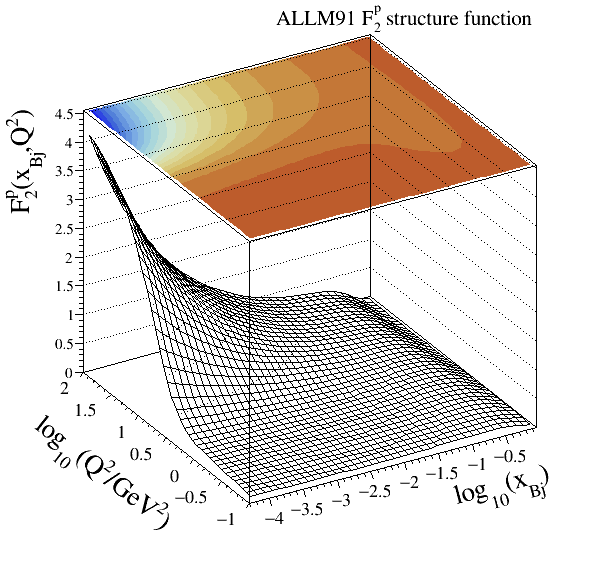
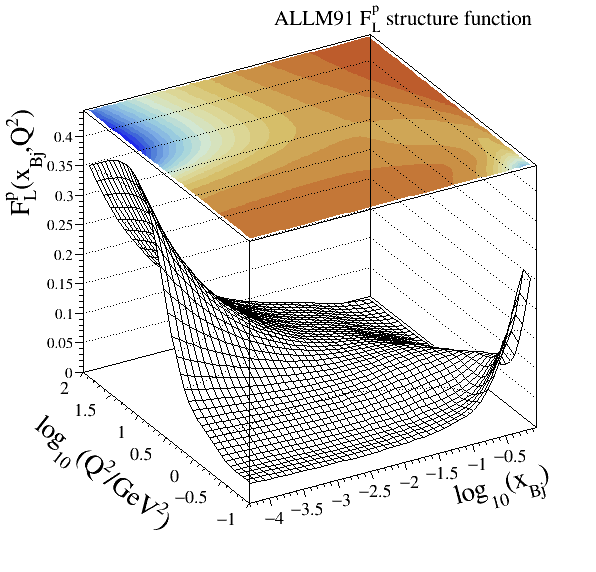
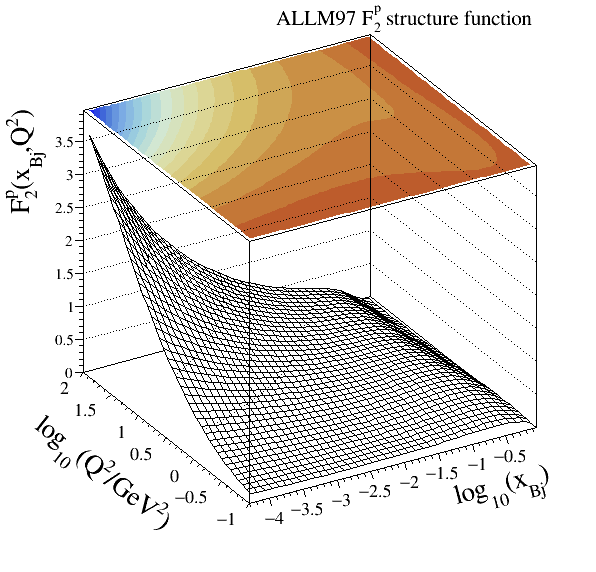
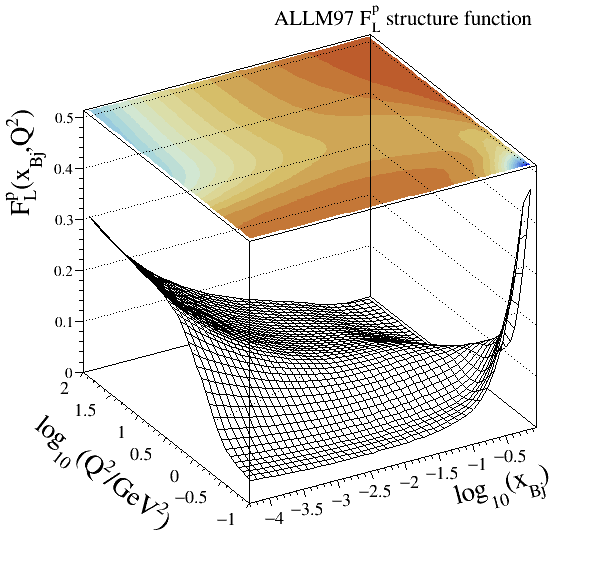
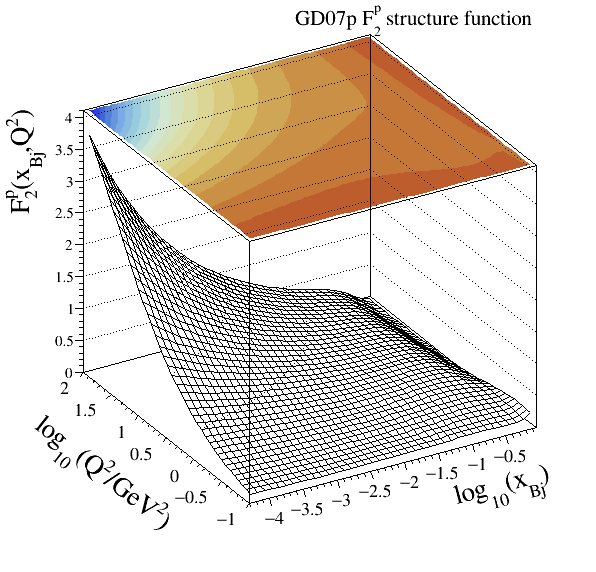

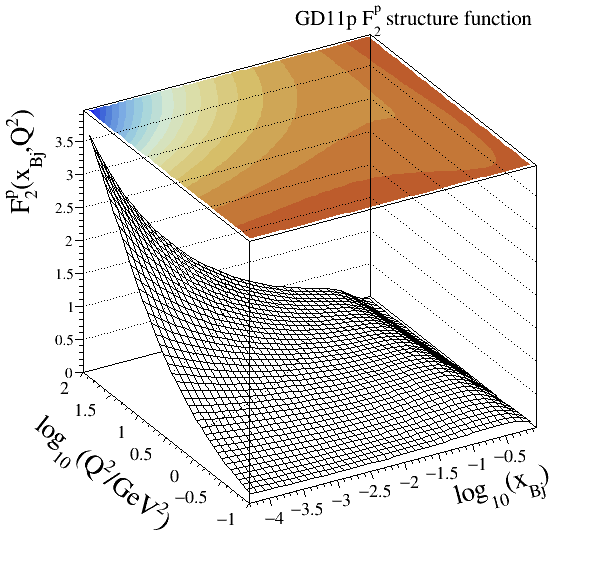

Resonance models#
Fiore-Brasse#
Note
Legacy code:
101Structure function modelled: \(F_2\)
-
-
class FioreBrasse : public Parameterisation#
Subclassed by FioreBrasseAlt
-
class FioreBrasse : public Parameterisation#
This parameterisation gives a very good description of photoabsorption in the resonance region from low to large \(Q^2\). It is designed to reproduce well JLAB and SLAC data.
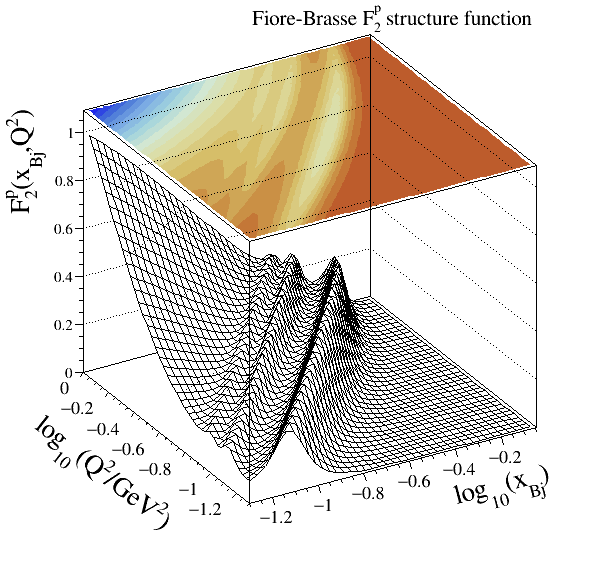

Christy-Bosted#
Note
Legacy code:
102Structure functions modelled: \(F_2\), \(F_L\)
Reference: [BC08]
-
class ChristyBosted : public Parameterisation#
-
class ChristyBosted : public Parameterisation#
The set developed by M.E. Christy and P.E. Bosted is emphasised on the very-low \(Q^2\) regime, with its particular use of JLAB’s Hall-C data on:
inclusive inelastic (up to \(Q^2simeq\) 7.5 GeV²),
photoproduction at \(Q^2\) = 0, and
DIS data at high-\((Q^2,W)\).

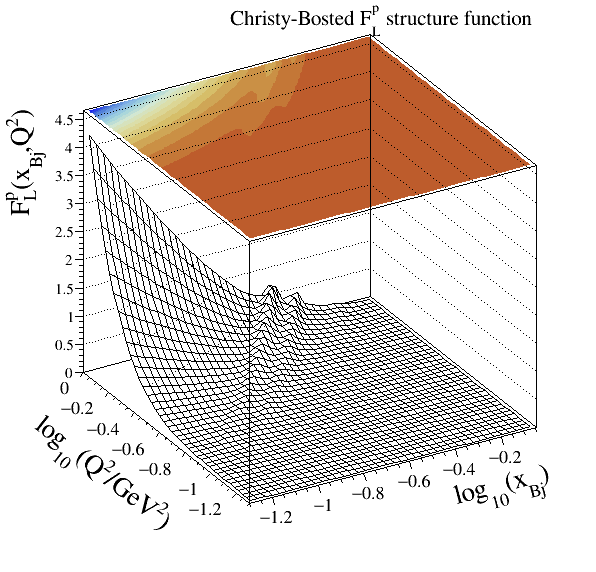
CLAS#
Note
Legacy code:
103Structure functions modelled: \(F_2\)
Reference: [O+03]
-
class CLAS : public Parameterisation#
-
class CLAS : public Parameterisation#
Perturbative models#
MSTW grid#
-
class Grid : public Parameterisation, private GridHandler<2, 2>#
External interfaces#
Several other models can also be interfaced through a base partonic structure functions interface allowing the conversion of PDFs into \(F_2\)/\(F_L\) structure functions. This object has the form:
-
class PartonicParameterisation : public Parameterisation#
Subclassed by PartonicStructureFunctions, LHAPDFPartonic
Among these is the LHAPDF interface:
Note
Legacy code: : The legacy-equivalent signature follows the convention
1MSSSSSS, where:Mspecifies the set of partons included in the sum rule: : -0: all partons,1: valence quarks only, and2: sea quarks only.
SSSSSSis the integer LHAPDF ID code for the selected PDF set.
Structure function modelled: \(F_2\) [1]
Reference: [WBG05]
-
class LHAPDFPartonic : public PartonicParameterisation#
-
class LHAPDFPartonic : public PartonicParameterisation#
If linked to LHAPDF, CepGen may build the \(F_2\) structure function from quark/gluon PDF content.
It is computed as follows:
